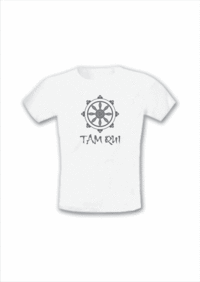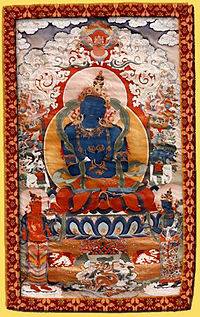Bankei Yotaku
From Buddha World
Bankei Yōtaku (1622-1693) was a well-known Rinzai Zen Buddhist master, and the abbot of the Ryomon-ji and Nyoho-ji. Bankei is most well known for his talks on the Unborn as he called it. Bankei's brilliance and directness reminds one of the style and approach of the ancient masters of the Ch'an tradition during the T'ang Dynasty.
Origins
Bankei Yōtaku was born in 1622, in Harima Province to a samurai turned medicine man named Suga Dosetsu. His boyhood name was Muchi. Bankei's mother bore the last name of Noguchi, and little more is known of her, other than that the society of the time reified her as 'Maya who begot three Buddhas,' - Maya being the mother of the historical Buddha, Shakyamuni. Bankei had four brothers and four sisters. His eldest brother, Masayasu, was a skilled physician and his second eldest brother was a practitioner of the Pure Land school of Buddhism. Hence Bankei's mother was likened to Maya, Masayasu to Yakushi - the Buddha of healing, his second eldest brother to the Buddha Amidha, and Bankei himself to Shakyamuni Buddha. Bankei was a rebellious and mischievous child, though he showed remarkable intelligence. When Bankei was 11, his father passed away, and in the following year he entered school. Here he was taught many of the Confucian texts. At this time, Bankei was young and full of questions and the Confucian classics he was being taught confused him greatly. One day, the teacher read a line from one of the 'Four Books' of classic Confucianism: "The way of great learning lies in clarifying bright virtue." In the unwitting spirit of Socrates, he then entered a heated exchange with his teacher imploring them for the meaning of this. Bankei felt no satisfactory answers were given. This gap in Bankei's understanding gave birth to many doubts and questions, and so he seized most every chance to question others on their knowledge. He would implore Confucian and Buddhist scholars and attend various religious gatherings in search of answers. All of this, however, proved futile for him. He became so distraught in his need to find answers that school was no longer a priority for him, and in 1633 he was kicked out of his family home. A friend of his family, Yūkan Nakahori, allowed Bankei to stay in a small hut nearby. Being a bit eccentric, Bankei etched into a slat of wood "Practice hermitage" and placed it outside of his little hut.
Enlightenment
It is likely that Bankei began practicing Shin Buddhism during this time. It is known that when Bankei was 15 he trained at a Shingon temple, where he apparently gained some footing in sutra study. However, Bankei was not satisfied with the Shingon approach and left that following year. At 16 he walked from Hamada to Ako to see a Rinzai Zen priest named Umpo Zenjo at Zuio-ji. Bankei wasted no time with Umpo and implored him on the meaning of bright virtue, to which Umpo advised the only path toward such understanding could be had through the practice of zazen. Bankei was intrigued by this advice and ordained as a monk at Zuio-ji under Umpo. It was here he received his Buddhist name Yōtaku (meaning 'Long Polishing of the Mind Gem'). When Bankei turned 19 he left Zuio-ji shortly after and travelled through Kyoto, Osaka and Kyūshū in search for an answer to his question. During his travels he would stay over at temples or sleep in the open wilderness, scrounging by as a beggar. In 1645, at age 24, Bankei returned to Zuio-ji no wiser than the day he left. At this time Umpo informs him that the answer which he seeks can only be found within, not through an intermediary. Bankei left shortly after his return and built a small hut nearby and lived as a hermit. He would sit for rigorous hours practicing zazen. He had given up bodily comfort and had no other goal during this time aside from coming to a complete understanding of things. His practice truly bordered on asceticism. He practiced this way for many years, but eventually the bodily neglect caused him to contract tuberculosis. He sought the care of a medicine doctor who gave the prognosis of death. It was during this near-death experience that Bankei attained enlightenment, later stating of the experience:
- "I felt a strange sensation in my throat. I spat against a wall. A mass of black phlegm large as a soapberry rolled down the side...Suddenly, just at that moment...I realized what it was that had escaped me until now: All things are perfectly resolved in the unborn."
Following this breakthrough his doubt and questioning ceased while his physical condition turned for the better. Once strong enough to travel again, he returned to Umpo to relay his experience to him. Umpo confirmed his enlightenment. He sent Bankei off to have his understanding further evidenced by Gudo Toshoku, another Rinzai master.
Seeking confirmation
At the age of 26 Bankei went to Gifu Prefecture to Daisen-ji where Gudo was abbot. However, when Bankei arrived Gudo was attending to another temple of his in the countryside. So Bankei visited the temples of other Zen teachers in the area, none of which had priests with the proper understanding themselves to confirm his understanding. After a year living in the countryside near Daisen-ji, Bankei travelled back to Umpo once again. In 1651, Bankei heard that a Ch'an master had arrived in Nagasaki by the name of Dosha Chogen. Umpo advised he go see the Ch'an master, and Bankei set off for Nagasaki hoping to finally have his enlightenment confirmed. Bankei found Dosha Chogen at Sōfuku-ji, a Chinese style temple. Dosha confirmed Bankei's understanding on their first meeting, but also informed Bankei that his understanding was incomplete. Bankei was offended by this initially and refused to accept it. Yet he stayed at the temple for a bit to observe Dosha's ways, eventually realizing what Dosha had insisted was true. So Bankei stayed on at Sōfuku-ji practicing under Dosha. While Bankei lived among the other monks at the temple, he refused to chant the sutras with them in Chinese. In 1652, while meditating with the congregation, Bankei experienced final enlightenment. Dosha confirmed this the next day, stating Bankei had finally settled the Great Matter. Bankei then refused a senior position in the monastery, preferring his unassuming existence instead working in the kitchen. The following year Bankei returned to Harima shortly, and then left for Yoshino in the Nara Prefecture to live as a hermit yet again. In the mountains of Yoshino Bankei authors some Buddhist chants pertaining to the Unborn while living in silent retreat there.

 По-Русски
По-Русски
